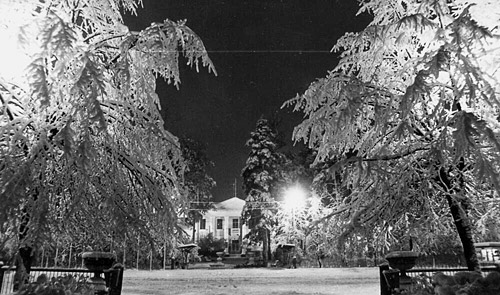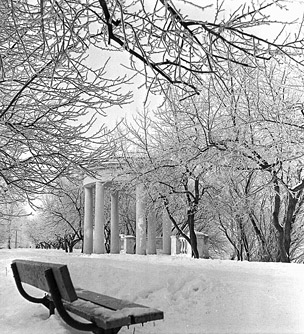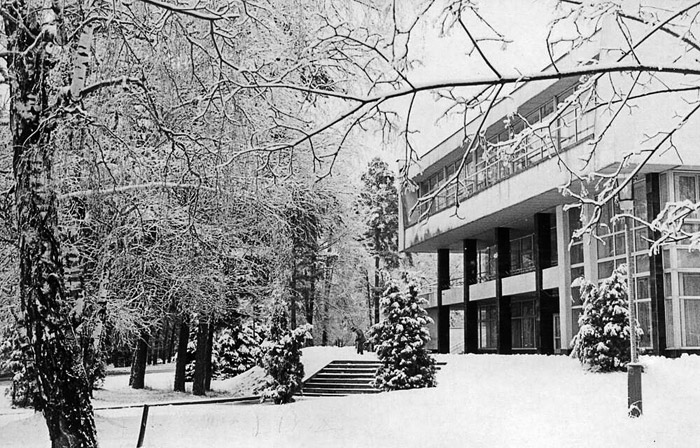
Electronic english version since 2022 |
The newspaper was founded in November 1957
| |
About what the newspaper wrote on this day
21 years ago
No. 50 (3688), 26 December, 2003
Happy New Year!
In these pre-New Year days, our e-mail box is swollen with New Year greetings and congratulations every day. And it is especially pleasant to receive news from old friends of the newspaper. And we know that on New Year's Eve, many Dubna families will definitely remember their friends and raise a toast "to those that are in the sea" ... in the sea of political, economic and everyday changes, do not part with the memory of Dubna, that are faithful to old friendships and seek new ways to develop it.

It so happened that the annual cycle is the most significant in human life. For some reason, it is on the New Year that we always place great hopes, make wishes, make plans. And on the eve of the holidays, we sum up the results, note the elements of luck, evaluate the efforts expended.
In the last days of the outgoing year, we turned to the Institute's staff with two traditional questions: what will you most enjoy remembering on New Year's Eve and what hopes do you have for 2004…
* * *
 The outgoing year has been fruitful for the Flerov Laboratory. Three large experiments have been implemented and the fourth is coming to an end. An experiment on the chemistry of element 112 was carried out for the first time. In summer, the largest International Forum "Nucleus-Nucleus Collisions - 2003" was held in Russia for the first time. The arrival in Moscow of 250 scientists from 33 countries of the world was evidence of recognition of the merits of Russian scientists in this field. The title of Academician of the Russian Academy of Sciences and Cavalier of the Order "For Services to the Fatherland" was awarded to Scientific Leader of the Flerov Laboratory Yu.Ts.Oganessian. Finally, this year, new elements 115 and 113 were synthesized.
The outgoing year has been fruitful for the Flerov Laboratory. Three large experiments have been implemented and the fourth is coming to an end. An experiment on the chemistry of element 112 was carried out for the first time. In summer, the largest International Forum "Nucleus-Nucleus Collisions - 2003" was held in Russia for the first time. The arrival in Moscow of 250 scientists from 33 countries of the world was evidence of recognition of the merits of Russian scientists in this field. The title of Academician of the Russian Academy of Sciences and Cavalier of the Order "For Services to the Fatherland" was awarded to Scientific Leader of the Flerov Laboratory Yu.Ts.Oganessian. Finally, this year, new elements 115 and 113 were synthesized.
"...I would say that at first glance, this year looks more productive than the previous ones. But the results do not fall from the sky, they are the result of a lot of work done in previous years," FLNR Scientific Leader Academician Yu.Ts.Oganessian says. "We cannot consider the events of this year in isolation from what we did before and will do next year. Our results were obtained not by a separate group, but by the entire Laboratory. We work at the limit of experimental capabilities and it makes all departments of the Laboratory (and especially the Department of Accelerators) to work very intensively. I think it is already known at the Institute that many FLNR employees do not have days off, the experiment goes on around the clock, continuously and we are always short of time..."
* * *
Many guests from CERN that visited LPP highly appreciated the quality of the detectors that are manufactured here for the LHC experiment projects. According to the acting head of the department V.D.Peshekhonov, this year, two eight-layer transition radiation detectors - trackers for the internal detector of the ATLAS facility were assembled, tested and sent to CERN.
"The assembly of two more detectors is under completion these days," V.D.Peshekhonov says, "after their testing in February-March, they will also be sent to Geneva. We hope that our Western partners will meet the technological tasks of manufacturing components and from the beginning of the new year, mass work on assembling of the other 12 detectors will start.
"As for our "signature products" - large-area straw detectors that were manufactured on two production lines, 15 two-layer straw chambers of the COMPASS spectrometer tracker successfully operated in a six-month physics session at CERN and demonstrated good parameters.
The work in 2004 will be no less intense, for each year brings us closer to the start of experiments at the LHC. In particular, under the ATLAS project, more than half of all equipment will have to be assembled, tested and sent to CERN. Further methodical investigations of the parameters and new developments of straw detectors will be carried out. We wish all our colleagues and "related" partners a good New Year's mood and success in 2004."
* * *
 The chief researcher at DLNP Professor Yu.A.Budagov supervises research in two areas at once in a wide range of scientific investigations implemented by JINR at Fermilab and CERN. A week before New Year, he returned from the USA, where he and his colleagues carried out an experiment at the CDF facility at the Tevatron.
The chief researcher at DLNP Professor Yu.A.Budagov supervises research in two areas at once in a wide range of scientific investigations implemented by JINR at Fermilab and CERN. A week before New Year, he returned from the USA, where he and his colleagues carried out an experiment at the CDF facility at the Tevatron.
"The year was very eventful... Among the scientific events, I would undoubtedly highlight the following - our recent joint investigation with Italian physicists allowed us to obtain the first information about the so-called processes "with very high multiplicities". They occur in the interaction of protons and antiprotons in the experiment at the Tevatron in Fermilab that was registered at the CDF facility - the collider detector.
Thus, the predictions made by the JINR theorists were confirmed. In this regard, the Bologna-Pisa-Dubna agreement on cooperation in this area is currently prepared.
We ensured the reliable operation of the equipment at the CDF facility in Fermilab and it yielded results - the mass of the top quark was measured. The value of this result, obtained by us together with colleagues from Italy and America, is that the "top mass" was measured after a long shutdown of the Tevatron and the modernization of the CDF facility and our result marks the beginning of top quark physics, when investigations move from single events to statistically rich database. The top quark is one of the mysterious objects of physics, its mass is almost equal to the mass of the gold nucleus (176 GeV) and its "mining" is even more difficult - bit by bit. In the future, our result will be enriched statistically.
In parallel, we achieved another impressive result last year: JINR's international commitments were fully and on time implemented - the ATLAS calorimeter "barrel" was constructed at CERN from modules manufactured at JINR. A facility was constructed in which mass and dimensions are combined with unique assembly precision. The DLNP employees made a significant contribution to this success, our newspaper has already written about it.
The Dubna newspaper has always been attentive to us and I want to wish your staff to "go on the attack" on physicists and pinch off at least a small part of their budget funds. With this money you will purchase new equipment and then it will be possible to distinguish a person from a detector in your photographs. I wish your creative staff success in the coming year!"
* * *

Head of the FLNR base facilities B.N.Gikal has recently returned from the capital of Kazakhstan, Astana, with good news for the staff: a decision has been made to develop an Interdisciplinary Research Complex at the L.N.Gumilev Eurasian National University based on the LS-60 heavy ion accelerator that will be designed and constructed at FLNR.
"The outgoing year was rich in events," B.N.Gikal said. "A reliable and close-knit staff, in which I was lucky enough to work, ensures the implementation of a large programme for the synthesis of superheavy elements. At the same time, it not only supports the complex accelerator economy of the laboratory, but also designs and constructs new cyclotrons. What is very important is that there are no "first" and "second" specialists in our staff, everyone clearly meets the tasks and in the development process, sees the final goal - development of a new product, as they say today.
In Astana, I was offered scientific and technical supervision for the implementation of a new project. And today, we have to estimate what has already been done and choose the best scientific and technical solutions. In the process of discussing various variants with our Kazakh colleagues, we settled on the DC-60 cyclotron project - essentially a new specialized machine for meeting applied problems that has no analogues in the world, highly automated and easy to operate, with reliable protection. All our experience in designing and constructing the U-400 and U-400M cyclotrons, the IC-100 cyclic implanter, the practice of creating new ECR sources, channels for irradiating polymer films - all this and much more will be used in the construction of the Interdisciplinary Research Complex for the L.N.Gumilev Eurasian University in Astana."
* * *
Vitaly Lazarevich Ginzburg was invited at the end of October to the anniversary seminar in memory of Ilya Frank at FLNP. But he could not participate in it due to health reasons. And when it became known that he had been awarded the Nobel Prize in Physics for 2003, we could not resist the temptation to interview him anyway. Not having much free time, Vitaly Lazarevich agreed to answer our questions...
How do you remember Ilya Frank - in a few words?
- I met Ilya Mikhailovich probably in 1937 or 1938, because I went to I.E.Tamm's theoretical seminar at the Lebedev Physical Institute and was present at the discussion of Tamm-Frank's paper on the Vavilov-Cherenkov radiation theory.
What would you like to wish the international JINR staff?
- In regard with the New Year celebration, I take this opportunity to wish the JINR staff members success in their work. Specifically, I would like to hope for progress toward the centre of the island of stability of transuranic nuclei. It would be interesting, in particular, to continue searching for long-lived transuranic nuclei in cosmic rays (I mean the tracks of these nuclei in meteoritic matter).
* * *
One of the last big musical events of the outgoing year - the Christmas evening of the Dubna Symphony Orchestra this time did without the participation of our active author Antonin Janata. A rare case! But if he had not gone home to Prague for Christmas, then of course, in this issue you would have already read his next note. But instead, read his New Year interview!
"The most pleasant memories concerning the outgoing year are associated with my grandson. He was born in December last year. And I had fun with him when I came home.
In July 2003, a large international conference was held in Prague, actually "two in one" - on physics at the LHC and on the traditional topic of "Symmetries and spin". There were many good reports. It is pleasant that the participants highly appreciated the work of our collaboration that reported on the results of the session at the COMPASS facility.
I would like the cultural life of Dubna to become even more lively in 2004. There is a wonderful organ in the concert hall of the Choir of boys and young men and it would be good to regularly hold organ concerts with commentary by a musicologist and employees from those Member States with rich organ traditions could take part in developing the repertoire. For example, in December one could listen to the Czech Christmas Mass by composer Jan Jakub Ryba that is traditionally performed in one of the cathedrals of Prague."
* * *
The Academy of Sciences held a ceremony to award prizes for the best scientific publications in journals published by the International Academic Publishing Company (IAPC) "Science/Interperiodica". Among the winners of the prize for the best scientific publications in 2002 were prominent JINR scientists Academician A.M.Baldin (posthumously), professors A.N.Sisakyan, A.I.Malakhov, V.G.Zinov, V.I.Yukalov. The winners were congratulated by the President of the Russian Academy of Sciences Academician Yu.S.Osipov.
* * *
The inauguration ceremony of the city mayor V.E.Prokh that won a convincing victory in the elections - more than 71% of citizens voted for him, was held in the JINR International Conference Centre. It means that the future of our city is associated with his name and activities.
* * *
A conference was held at Dubna University, uniting activists of the establishment of a Russian-speaking scientific diaspora.
It was attended by the rector of the university O.L.Kuznetsov, vice-director of JINR A.N.Sisakyan, president of the American University in Moscow E.Lozansky, general director of the Association "House of International Scientific and Technical Cooperation" B.G.Saltykov, representatives of the Ministry of Foreign Affairs, the government of the Moscow Region. The possibilities and prospects of cooperation with our compatriots working abroad, establishing permanent contacts, compatible databases were discussed. Some reports were dedicated to current joint projects.
Columnist Irina LEONOVICH,
photos from different years by Yury TUMANOV